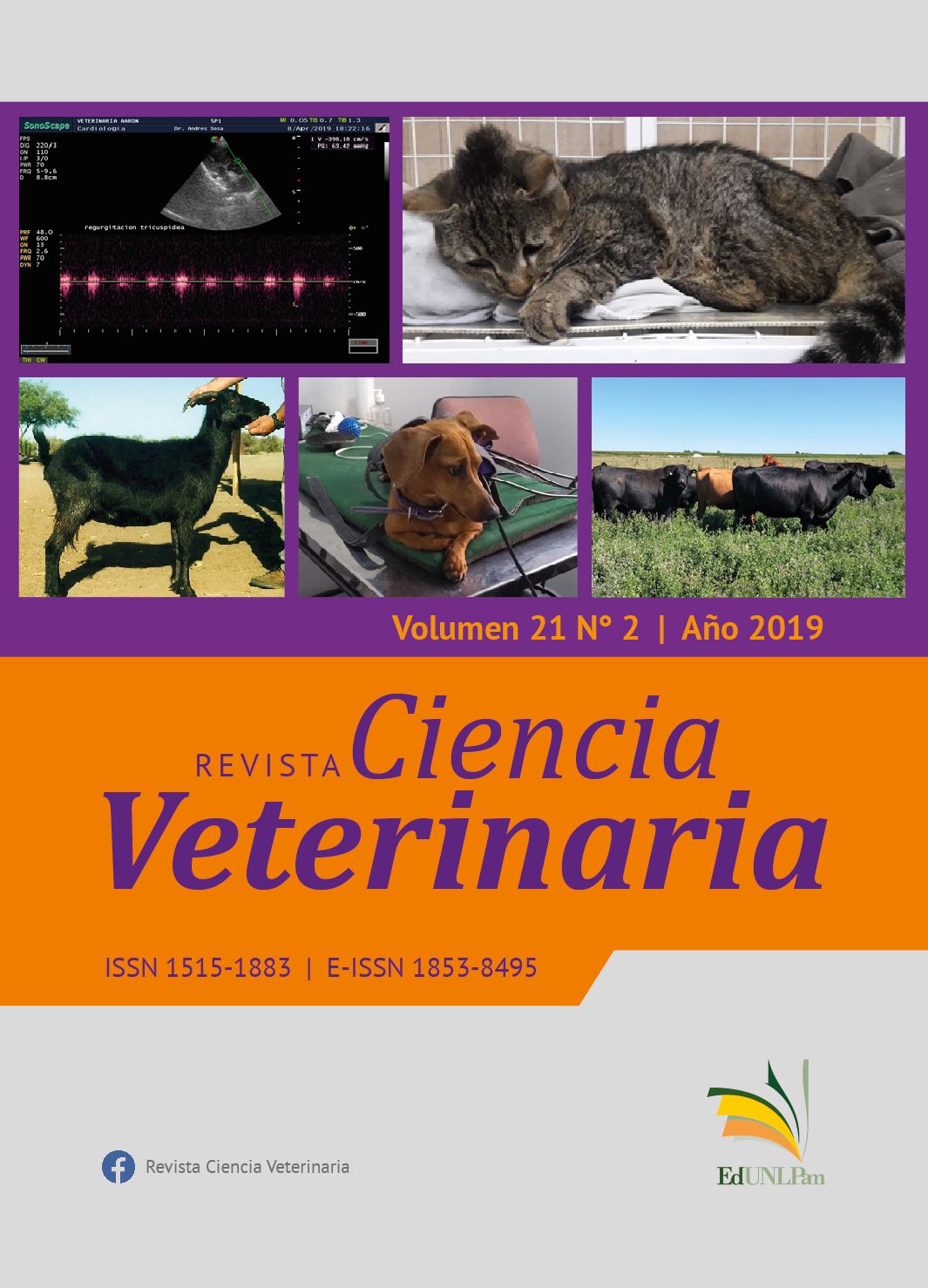A cattle raising model for the National Livestock Farming
DOI:
https://doi.org/10.19137/cienvet-201921205Keywords:
cattle raising, bovine, model, production systemAbstract
The objective is to represent the national production system in balance for cattle raising through a model that includes characteristic indicators at the macro level, such as weaning percentage, extraction rate, percentages of females in slaughter, death rate, cows’ useful life, among others. For that purpose, SENASA stock bases series 2003- 2018 (16 years) arising from FMD vaccination were used, slaughter bases arise from the historical information published for the National Secretary of Agroindustry. The first is a stock measure, represented by stocks at a certain time of the year, (March); the second is a measure of flow, represented by the quantity of slaughtered animals during
throughout the year. It is concluded that the model stock consists of 53,7 million heads, from which 22,6 million are cows. Of the total slaughter, males represent 56,2%. Thus, the slaughter of balancing females is 43,8%. If all indicators are considered in relation to the stock of cows, setting theses as 100%, the female slaughter represents 25,3% and the one of males 32,5%, which represents an animal extraction rate for slaughter a 57,7%. National Weaning is located at 67,8%. Bulls represent a 5% regarding the cows’ stock. With a cow discard of the 10,1% – that are destined to slaughter – and a loss of females by death
of the 6,7%, a replacement of heifers is defined of the 16,8%. With that, cows’ useful life consists of 7 deliveries. Of the weaned calves, approximately half are destined to replacement (50,6%) and the other half (49,5%) to fattening. As a final comment it should be noted that it is a simplified representation of reality, whereby the conclusions emerged in this analysis framework, should be used with the limitations of the case. An attempt has been made to reflect all the livestock system with a single model, which may be used to estimate the possible evolution of the herd according to the current composition, analyze possible scenarios, analyze the relationship between indicators, infer the impact that may have measures to encourage some of the indicators regarding the remaining indicators and establish comparisons with livestock systems in other countries.
Downloads
References
Garzon JM , Torre N. Alta faena de hembras: por qué pone en riesgo el crecimiento de la ganadería Diario La Nación. 2019-07-19.
Secretaría de Industria. Ministerio de producción y trabajo. Informe Ganadero
(2019a) Nº 964 [Internet]Buenos Aires;2019[citado el 15-03-2019].Disponible en:
https://www.agroindustria.gob.ar/sitio/areas/bovinos/modelos/resultados/_archivos/
_Bolet%C3%ADn%20trimestral/000000-2019/000000-Bolet%-
C3%ADn%20N%C2%BA%2029%20MARZO%202019.pdf
Urcía, D..No estamos en una fase de liquidación, sino de eficiencia ganadera. Agrovoz. 2019-07-16.
Cámara de la industria y comercio de carnes y derivados de la Republica Argentina.
CICCRA Informe Económico Mensual. Documento N° 222. Julio 2019.
Decisión Ganadera. Faena de hembras recalentada y dos grandes responsables: China y la seca…. Decisión Ganadera. 6 abr 2018.
SENASA. Estadísticas bovinas [Internet] Buenos Aires.2019. Disponible en:
http://www.senasa.gob.ar/cadena-animal/bovinos-y-bubalinos/informacion/
informes-y-estadisticas
AACREA Producción de carne bovina de Argentina: Análisis de factores determinantes. Observatorio de la Cadena bovina argentina.[Internet] Buenos Aires;2012. Disponible
en: https://es.calameo.com/read/00194091985ce3b189558
López R, Dearma S, Ceballos y Cerminatti N. La tasa de extracción: un indicador… ¿o
un modelo?. Agromensajes.2016;45:42-46.
Secretaría de Industria. Ministerio de producción y trabajo. Informe trimestral Nº
[Internet]Buenos Aires;2019[citado el 30-07-2019].Disponible en: http://www.
minagri.gob.ar/sitio/areas/bovinos/modelos/resultados/_archivos//000001_Bolet%
C3%ADn%20trimestral/000000-2019/000001-Bolet%C3%ADn%20N%C2%-
BA%2030%20JUNIO%202019.pdf
Secretaría de Industria. Ministerio de producción y trabajo. Informe Ganadero
(2019b) Nº 967. Buenos Aires.
Downloads
Published
Issue
Section
License
Al momento de enviar sus contribuciones, los colaboradores deberán declarar , de manera fehaciente, que poseen el permiso del archivo o repositorio donde se obtuvieron los documentos que se anexan al trabajo, cualquiera sea su formato (manuscritos inéditos, imágenes, archivos audiovisuales, etc.), permiso que los autoriza a publicarlos y reproducirlos, liberando a la revista y sus editores de toda responsabilidad o reclamo de terceros , los autores deben adherir a la licencia Creative Commons denominada “Atribución - No Comercial CC BY-NC-SA”, mediante la cual el autor permite copiar, reproducir, distribuir, comunicar públicamente la obra y generar obras derivadas, siempre y cuando se cite y reconozca al autor original. No se permite, sin embargo, utilizar la obra con fines comerciales.








.jpg)

4.png)


7.png)



